Tsingtao Polizeitruppe
Chinese Police in
German Service 1898-1914 |
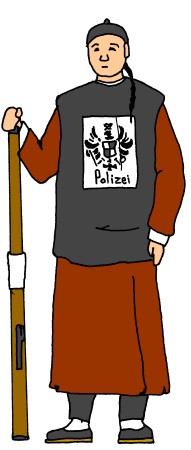 |
 |
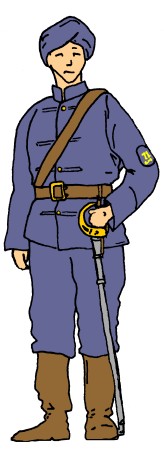 |
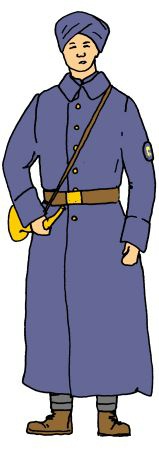 |
 |
|
Figure 1
Chinese Auxiliary Police
Peking 1901 |
Figure 2
Gendarme in Summer Uniform
Tsingtao Chinese Police |
Figure 3
Mounted Gendarme in Winter Uniform
Tsingtao Chinese Police |
Figure 4
Gendarme in Greatcoat
Tsingtao Chinese Police |
Figure 5
Seesoldat in
Winter Uniform
Tsingtao German Police |
Background of the
Tsingtao Chinese
Police
In 1898 six Chinese
policemen were
recruited in Tsingtao to maintain law and order amongst the growing
Chinese population in the city. By October 1899 their number had grown to 28
and to 60 by 1914
with some being mounted. The Chinese Police force
("Tsingtau Polizeitruppe" with their Chinese policemen
known as Gendarmes) was
commanded by German NCOs and officers
from the III. Seebataillon.
They are not known to
have performed combat duties during the Siege of Tsingtao in the First World War although at least one Chinese
police Gendarme (listed as Number 11) served as a spy behind Japanese lines
disguised as a coolie he reported back to the Germans in Tsingtao on
Japanese strengths and troops movements (see
"Askari und Fitafita" by
Thomas Morlang).
In Tsingtao there was
another police force, a German force made up
of personnel from the III. Seebataillon. They policed the German
garrison and the European population of Tsingtao.
In Peking and Tientsin
the German East Asian Expeditionary Corps also recruited small numbers
of Chinese auxiliary police.
I have so far been able
to find very little information on them besides a few photographs.
Uniforms of the Tsingtao
Chinese Police
The Tsingtao
Chinese Police wore the khaki uniforms of the
Chinese Company in Summer
and dark blue/grey uniforms in Winter. As with the Chinese Company there
appear to have been some irregular variations on the wearing of these
uniforms.
As with the uniforms of the Chinese Company, those of the the Tsingtao
police are a difficult topic to study mainly due to a shortage of source
materials and clear period photographs.
Summer Khaki Uniforms
The Chinese Police
initially wore the same uniforms as the
Chinese Company.
The Summer uniform was khaki, with a standing collar, no pockets or
shoulder straps and plain cuffs. The front was fastened with five yellow
metal buttons and a simple Chinese style tie across the breast from each button (some photographs show six
buttons and ties). Pietsch and Knötel illustrated the uniforms with braided
cuffs and more elaborately decorated chest braids though no photographic
evidence of these decorations has so far been seen.
Trousers were matching
khaki.
An oval bark blue patch
was worn on the upper left arm with the policeman's individual number
embroidered on it in yellow in both Arabic and Chinese characters. Rank
insignia was shown as one to three dark blue bands on both cuffs. Some
period photographs show an armband in the Imperial colours worn on the
left arm. Photographs c1910 onwards
show a similar khaki tunic worn but with a plain concealed front without
ties.
Winter Blue/Grey
Uniforms
The
Winter uniform was dark blue/grey, with a standing collar, no pockets or
shoulder straps and plain cuffs. The front was fastened with five yellow
metal buttons and a simple Chinese style tie across the breast from each button
(some photographs show six buttons and ties.
The trousers or riding breeches for mounted police were matching dark
blue/grey.
An oval bark blue patch
was worn on the upper left arm with the policeman's individual number
embroidered on it in yellow in both Arabic and Chinese characters. Rank
insignia was shown as one to three yellow bands on both cuffs.
Some photographs show
armed members of the Tsingtao Chinese police wearing the dark blue/grey
uniform with three light coloured stripes on their upper right sleeves.
It has not been established what these signify.
I have not seen any
evidence specialist insignia worn by the Chinese Police. Photographs of
their musicians have no swallows nests.
Headdress
Distinctly different styles of headdress were worn with the Summer and
Winter uniforms. With the khaki Summer uniform a traditional Chinese
conical straw hat was worn with tassels in the Imperial colours hanging
from the top. With the dark blue/grey Winter uniform a matching dark
blue/grey turban was worn.
Period photographs also
show traditional Chinese hats being worn such as the small peakless cap
with a pom-pom as worn by the Chinese Company. Pietsch illustrates a
taller embroidered cap being worn (as seen on the
Traditionsverband
website).
One uniquely Chinese
characteristic was their being allowed to wear their hair long in pigtails
trailing down their backs. The pigtails were then sometimes tucked into
the back of the belt. When the turban was worn the pigtails were coiled
inside.
Greatcoat
The greatcoat to accompany the dark blue/grey Winter uniform was single
breasted in matching cloth with six yellow metal buttons down the front.
It had the same dark blue/grey oval arm patch as the Summer and Winter
tunics.
In a plate seen on the
Traditionsverband website
Pietsch illustrates a khaki greatcoat with five
buttoned ties across the front and a buttoned hood. It has the usual
dark blue/grey patch on the upper left sleeve. I have not yet seen
period photographs of this greatcoat.
Footwear
The issue footwear was short brown boots with dark blue/grey puttees,
mounted Gendarmes wore riding boots. Period photographs also show
Chinese footwear in use such as straw soled sandals with white socks or
fur lined boots with the Winter uniform.
Weapons
For patrol duties the Tsingtao police were usually armed with a wooden
truncheon kept in a tubular leather holster on the left side of the
belt. Mounted Gendarmes were armed with the Prussian Army 1889 Cavalry
Sword.
Period photographs
also show dismounted Gendarmes armed with the Gew88 rifle. One
photograph (see below) shows a Gendarme armed with what appears to be an
Austrian Mannlicher rifle. I
have not seen found many clear period photographs of their bayonets but
the few images I have seen appear to be of S71 or possibly Pfm71
bayonets. Bayonet and sword
knots do not appear to have been used.
Equipment
The Chinese Police wore the same equipment as the III. Seebataillon, in
brown leather from the early 1900s. Prior to then the III. Seebataillon
and the Tsingtao Police had worn the same blackened leather equipment as
the I. and II Seebataillone. For most duties they wore only a leather
belt with a plain brass buckle. Some photographs show them wearing
buckles which may have the Imperial crown of the Seebataillone and at
least one period photograph seen close up shows them wearing Prussian
other ranks buckles.
When armed they carried 1895 ammunition
pouches and for marching order they wore backpacks with tent sections or
blankets, water bottles and bread bags. Mounted Gendarmes had Sam Brown
style belts with open buckles.
Uniforms of the German
Officers and NCOs
The German
officers and NCOs from the III. Seebataillon that commanded
the Tsingtao Chinese Polizeitruppe wore standard Seebataillon uniforms.
Uniforms
of the Tsingtao German Police
The German Police in
Tsingtao wore standard Seebataillon uniforms. Period photographs show them
wearing the peakless white naval onboard cap with a light blue hatband
and small imperial cockade. This hat was issued to all Marine Infantry
for wearing at sea but is rarely seen worn on land. The exception seems
to be the German Tsingtao Polizeitruppe who wear it in the few
photographs that I have found of them. Perhaps it was used as a way of
instantly telling them from other Marine Infantry. The German police
wore a white armband with the words for "Police"
in German and Chinese characters (see below for photos and full translation).
Another photo of the German police in khaki Marine Infantry uniforms
with what appear to be single chevrons on the left sleeve, possibly in
the imperial colours.
Period photographs show
members of the German East Asian Occupation Brigade on local police duty
in Tientsin or Peking wearing insignia similar to the Tsingtao Police in
the form of dark ovals on the upper left arm with numbers and Chinese
characters (see East Asian Occupation Brigade Page).
| |
|
|
| |
The
Illustrations
Figure 1 is based
on a photograph of a
Chinese Auxiliary Police Soldier in German service in Peking in
early 1901.
He wears traditional Chinese costume with a large
patch in the centre of his tunic bearing a German heraldic eagle and the
word "Polizei" (or police). Interestingly the eagle used is the old
Prussian one in official use up until 1871 when it was formally replaced
by an eagle bearing another eagle in its centre shield rather than the
Prussian quatrain. He is armed with what appears to be an antiquated
Chinese musket. The original photograph upon which this illustration is
based can be seen on the
Boxer Aufstand website.
Figure 2
is based on a photograph of a Gendarme of the Chinese Tsingtao Police
taken c1910-14.
He wears the later style
of khaki Summer uniform seen from c1910 onwards with a plain concealed
front (see Chinese Company
Page for illustrations of the earlier khaki tunic with Chinese ties
across the front). He has a brassard in the Imperial colours on his left
arm. His headdress is the Chinese style conical straw hat with tassels
in the Imperial colours. He wears dark blue/grey puttees over brown
leather boots. His equipment consists only of a brown leather belt with
the Marine Infantry Imperial belt buckle (or possibly a Prussian buckle
as seen in some period photographs of the Chinese police in Tsingtao).
He may well carry either a truncheon or a bayonet on his left side as
seen in some period photos.
Figure 3
is based on a photograph of a Mounted Gendarme of the Chinese Tsingtao Police.
He wears the dark
blue/grey Winter uniform
with five yellow metal buttons and Chinese ties across the front. On his
left arm can be seen the identification number with his personal number,
71 in yellow Arabic and Chinese characters. His headdress is the dark
blue/grey turban. His matching riding breeches are tucked into brown
leather riding boots. His Sam Brown style equipment is also in brown
leather with an open belt buckle and a Prussian 1889 Cavalry Sword
without a sword knot.
Figure 4
is based on a photograph of a Gendarme of the Chinese Tsingtao Police.
He wears the dark
blue/grey Winter uniform
with the single breasted greatcoat five yellow metal buttons and Chinese
ties across the front. On his left arm can be seen the identification
number with his personal number in yellow. His headdress is the dark
blue/grey turban. He wears dark blue grey puttees with short brown
leather boots. His equipment is a brown leather belt with a blank yellow
metal belt buckle. He carries a signalling horn.
Figure 5 is based on a
photograph of a Marine of the III. Seebataillon on Police Duty taken
in China shortly after the Boxer Rebellion. He wears the dark blue M1893
Litewka tunic commonly worn by the Seebataillone on overseas active
winter service at the time of the Boxer Rebellion. It has a concealed
front, no exterior pockets and gathered cuffs with one small horn
button fastening each. Note the Seebataillon white shoulder
straps with yellow Imperial crown, crossed anchors and battalion numeral
as on the home and tropical uniform and white collar patches with the Seebataillon yellow
double Litzen. On his left arm he wears the white armband identifying
him as being in police service in German and Chinese (see below).
While most of the III. Seebataillon in
Tsingtao wore the dark blue peakless cap on land based duties the German
Tsingtao police usually wore the on board cap. It was a white peakless naval style cap
with a light blue hatband and a small imperial cockade.
The trousers are
those to match the dark blue tunic with white piping tucked into brown
leather marching boots. the equipment has 1895
ammunition pouches on a brown leather belt fastened with the Marine
Infantry Imperial belt buckle. His company coloured bayonet knot can be seen hanging by his left side.
| |
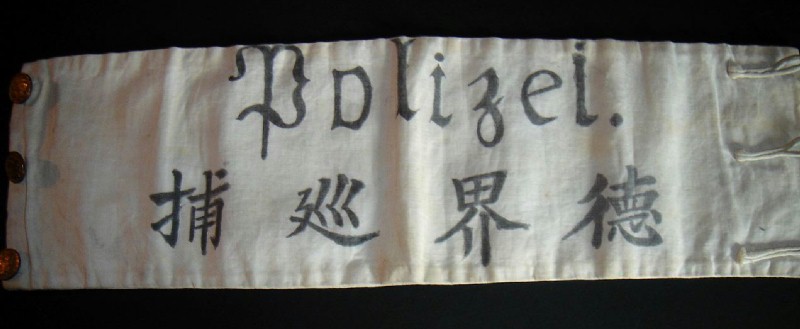
Brassard worn by the German Police in Tsingtao
Photo ©
Doppler Collection |
|
| |
"Polizei" is the German word for
police, that's the easy part. Ken Kopp of the
Center for the Pacific Rim,
University of San Francisco kindly translated the Chinese for us.
"The Chinese characters, read from right to left, are-
"DE JIE XUN BU".
"DE" is the shortened form for Germany, "Deyizhiguo" (Deyizhi is
phonetically "Deutsche") which is normally shortened further to just
"Deguo" (GUO is nation or country, hence FAguo for France, MEIguo
for
America etc).
JIE is a zone, region or territory, here indicating the concession
area.
XUN is to patrol and
BU is to catch or arrest.
Interestingly, the Chinese did not use this word (xunbu) for
anything
but the concession police employed by the various Powers in their
own
zones, whether native or foreign.
For their own police forces
operating
in the territory not occupied by foreigners they used the
formulation
JINGCHA the individual words mean "guard" and "observe" but really
it
is just a compound that means "police") and this is the modern word
used
today in Taiwan, China and Hong Kong." |
|
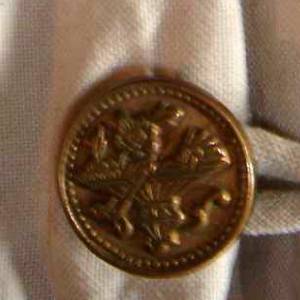
One of the three matching badges
attaching the brassard
Note the Chinese design
Photo ©
Doppler Collection |
|
|
|
| |
|
|
Rank
Insignia of the Tsingtao Chinese Police
| |
|
|
| |
As with so much about Chinese police in German service there is still a
lot for me to find out about NCO ranks and their titles. What is certain is that
there were at least three grades of NCO, that they wore one to three bands
around their cuffs and that these were dark blue on the khaki uniform and
yellow on the dark blue/grey uniform. |
|
|
|
|
Figure A shows the single dark blue band
around the cuff worn by junior NCOs. Knötel illustrates the rank insignia of
these 1st grade NCOs with khaki lace or stitching under the rank insignia on the
braided khaki uniform. This NCO also wears the arm badge bearing his personal
number.
Figure B shows the two dark blue bands
around the cuff worn by intermediate NCOs. This NCO has plain cuffs also wears the
arm badge bearing his personal number.
Figure C shows the three yellow metallic
lace bars around the cuff wore by Senior NCOs. One photograph on the
Kukri website
shows a
senior Chinese Gendarme wearing the dark blue/grey Winter
uniform with three rank bars on his cuffs. He wears a small Chinese
peakless cap with a pom-pom. Like a German senior NCO, he carries a
sword rather than a bayonet and and has six metal buttons down the front
of his tunic without the Chinese ties and no personal
number badge is worn. |

Figure A
Junior NCO |
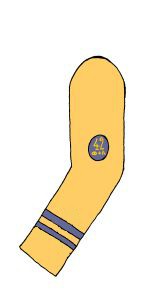
Figure B
Intermediate NCO |
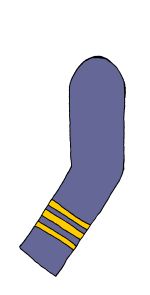
Figure C
Senior NCO |
| |
|
|
|
|
| |
|
|
| |
Period Photographs
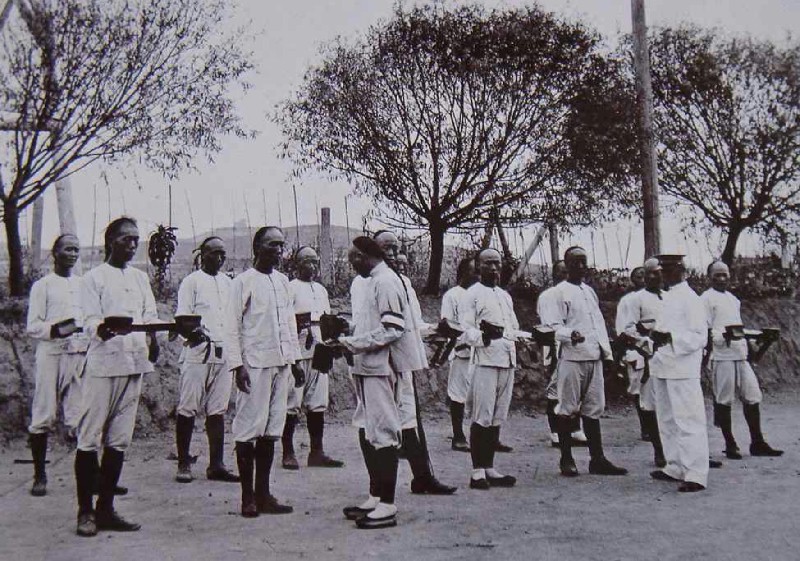
Chinese Tsingtao Polizeitruppe
Photo
© Doppler Collection
This is a photograph showing the Tsingtao Chinese Police
at what looks like a swearing in ceremony for new recruits.
The police are all wearing light khaki
summer uniforms. Their Chinese style tunics have four or five tie
attachments down the front, and small standing collars. The
trousers are matching and are tucked into dark blue/grey puttees.
Most of the men wear German leather marching boots but some have
Chinese sandals with white socks. The figure in the centre
foreground has an armband in the German imperial colours. None of the Chinese wear any headdress,
presumably for the purpose of the ceremony.
On the right of the photograph is
their German commander. The Tsingtao Chinese Police were commanded
by German officers and NCOs from the III. Seebataillon and Naval
Batteries. It is difficult to make out the details of this
figure's uniform. He is certainly wearing a white summer uniform
and dark peaked cap, and could belong to either the Marine
Infantry or Imperial Navy.
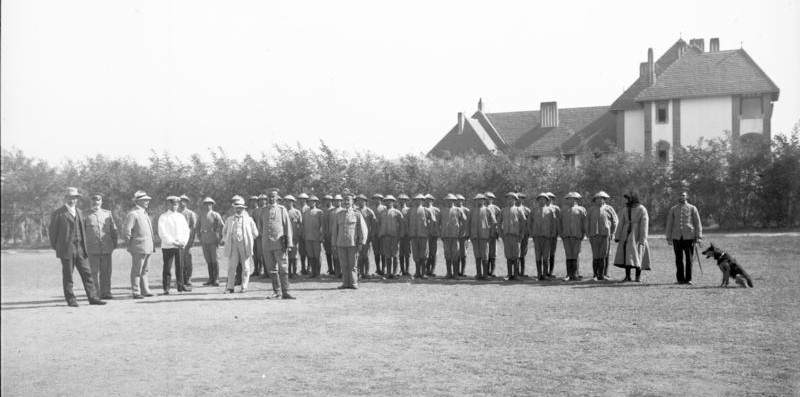
Chinese Tsingtao Polizeitruppe
Photo from Bundesarchiv /
Wikipedia
This is a photograph showing the Tsingtao Chinese Police
on parade with their German Officer and NCO from the III.
Seebataillon. The police are all wearing light khaki
summer uniforms. The
trousers are matching and are tucked into dark blue/grey puttees.
They wear Chinese conical hats.
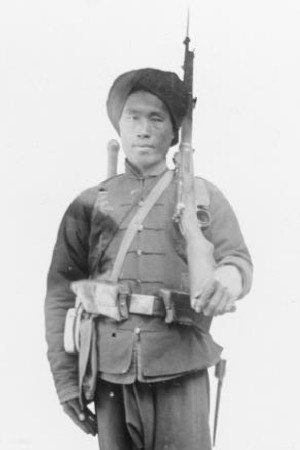 |
|
Chinese Polizei-Soldat
from the Tsingtao Polizeitruppe
Photo from Bundesarchiv /
WikiCommons
He wears the blue/grey Winter
uniform the front ties of which can clearly be seen. It appears
that he is wearing the winter uniform over the khaki Summer
uniform for extra warmth. He wears matching trousers and turban.
Curiously his rifle looks like an
Austrian
Mannlicher 86 or 88 rather than the
standard German Gew88 usually carried by the Chinese
Polizeitruppe. He
carries full marching equipment with Austrian ammunition pouches, a
bread bag slung over his left shoulder and the handle of an
entrenching tool visible over his right shoulder. |
|
|
Other Chinese
Police Uniforms seen in Period Photographs
Several photographs have been seen showing Chinese police in other
styles of uniform labelled as under German command or seen
alongside German soldiers. It is not certain
in all these cases which units the Chinese belong to and if they are
under German command. Some of these photographs are discussed below.
One photograph which appeared on the
Axis History Forum
sometime ago showed
an armed Chinese soldier alongside members of the East Asian Occupation
Brigade wearing a uniform which may be khaki judging from the similar
shade of the German uniforms in the same grouping with a matching turban. The
tunic has a concealed front, standing collar and dark coloured shoulder
straps. He wears a single chevron in the Imperial colours on the left
sleeve and wears a sash around his waist. The sash may be red as worn by
colonial police units in the African colonies. He may possibly be an
auxiliary policemen employed by the German forces in Peking and
Tientsin. The uniforms of the German soldiers in this photograph dates
the photograph between 1901 and 1905.
A photograph in
"Uniforms of the German Soldier - 1870 to the
End of World War One" by Alejandro M. De
Quesada shows soldiers of the III Seebataillon alongside Chinese
troops wearing short brimmed straw hats with dark hatbands and khaki
uniforms with the usual Chinese ties across the chest. They have
unidentified dark shoulder insignia and the NCOs have dark chevrons on
their left sleeves. The photograph is not clear enough to positively
identify the weapons but they look like Austrian Mannlicher rifles with
German exported 1907 bayonets. An NCO carries a larger unidentified
bayonet. These soldiers may be from the regular Chinese army but do not
appear to be from the German led Chinese Police or the Chinese Company.
Another photograph
dated between 1909-10 (which has been discussed by Rolf Selzer on the
Traditionsverband website) shows what may
well be Chinese armed police guarding the Tsingtao railway. They wear
peaked caps with dark hatbands and a large metal star badge on the front. Their
khaki uniforms have five buttons down the front, loops of dark coloured
ace on the cuffs, dark shoulder straps with Chinese characters and a standing collar.
On the right sleeve they wear a badge with their number in Arabic and
Chinese characters. Their khaki
trousers have broad dark stripes down the seems and are worn with
Chinese style lined boots. None of their uniforms or insignia looks
German. They are armed with what look like
Gew71/84 rifles and
German exported 1907 knife bayonets. These were made specifically to
order for the Chinese army.
Numbers of other Chinese were employed by the
German military in China as
labourers, guides, drivers, cooks,
servants and even aircraft ground crew to Günther Plüschow. They were not
usually uniformed although von Matuschka
illustrates a Chinese artillery driver working for the Marine
Expeditionskorps during the Boxer Rebellion wearing a Chinese peakless
cap, a Marine Infantry khaki tunic with dark blue Marine Artillery
riding breeches and riding boots. He carries a Sam Brown style belt and
German artillery sword.
Main Sources
"Askari und Fitafita - Farbiger Söldner
in den deutschen Kolonien" by
Thomas Morlang
(Published by
CH Links)
The following articles in
Zeitschrift für Heereskunde-
"Ergänzung zur Bewaffnung und Uniformierung der Chinesenpolizei in
Kiautschou" by Rolf Selzer
"Chinesische
Polizeisoldaten" by H Ehlers
illustrated by H Knötel
"Die Polizei in Kiautschou/Tsingtau" by Karlheinz Bühler
The following
articles on
Traditionsverband-
Polizeiuniform
by Arne Schöfert with illustration by P
Pietsch
Militaer Polizei China
by Rolf Selzer
Polizeitruppe Kiautschou
by Rolf Selzer
"Unsere
Marineuniform" by J. Zienert (published by Helmut Gerhard Schulz Verlag, Hamburg
1970)
"Deutsche Expeditionstruppen und
Schutztruppen" illustrated by Edgar Graf von Matuschka
(available from
Historischer-Bilderdienst )
"Imperial German Field
Uniforms and Equipment 1907-1918 Vol 3" by Johan
Somers
(Published by
Schiffer)
"Uniforms of the German Soldier - 1870 to the
End of World War One" by Alejandro M. De
Quesada
(Published by Greenhill)
Polizeigeschichte -
German Police History, including the
Tsingtao Chinese
Police
Seitengewehr
for another photo of the Chinese Polizeitruppe.
Special Thanks to Rolf Noeske, Arne Schöfert,
Chris Wood, Ken Kopp and Thomas Morlang for their help on this
page.
|
|
|
|
|
Askari
und Fita-Fita
Thomas Morlang
with a chapter on the
Chinese in
German service |
Imperial German Field
Uniforms
and Equipment 1907-1918 Vol 3
Johan
Somers
with a section on the
Chinese in
German service |
Uniforms of the German Soldier
1870 to the
End of World War One
Alejandro M. De
Quesada
with photos of the
Chinese in German
Service |
Unsere Marineuniform
1816-1969
Josef Zienert
with information in the
Chinese in German Service |
| |
|
|
|
| |
|
|
|
Please
contact me here if you have more
information or photos on this topic.
Back to
Main Menu for German Colonial Uniforms
|
|












